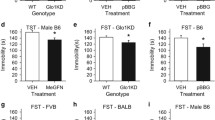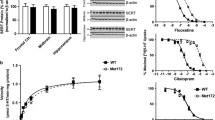Abstract
Rationale
The antidepressant response exhibits a characteristic delay. BALB/cJ mice respond to chronic, but not subchronic, treatment with selective serotonin reuptake inhibitors (SSRIs), providing a model of antidepressant onset. Identification of other mouse strains exhibiting this phenotype will provide additional tools for studying mechanisms of the antidepressant response.
Objectives
We aimed to identify inbred mouse strains that respond to chronic, but not subchronic, SSRI treatment in the forced swim test (FST). We also assessed whether response correlated with genotype at the functional C1473G polymorphism in tryptophan hydroxylase-2 (Tph2).
Methods
BALB/cJ, three closely related strains (BALB/cByJ, SEA/GnJ, A/J), and four distantly related strains (C57BL/6J, C57BL/10J, CAST/EiJ, SM/J) received the SSRI citalopram (0–30 mg/kg/day in drinking water) for ~4 weeks and were assessed for locomotion and FST behavior. Citalopram-responsive strains were assessed identically following ~1 week of treatment. C1473G genotypes were determined.
Results
BALB/cJ and related strains carried the 1473G allele and responded to chronic citalopram treatment in the FST. BALB/cJ, BALB/cByJ, and SEA/GnJ mice showed either no response or an attenuated response to subchronic treatment. Distantly related strains carried the 1473C allele and showed no response to citalopram. No relationship was found between the antidepressant response and baseline immobility or locomotion.
Conclusions
BALB/cJ and related strains exhibit an antidepressant response to chronic SSRI treatment that emerges over time and is likely a heritable trait. This antidepressant response is associated with carrying the 1473G allele in Tph2. In conclusion, BALB/cJ and related strains provide valuable models for studying the therapeutic mechanisms of SSRIs.









Similar content being viewed by others
References
Bech P, Tanghoj P, Andersen HF, Overo K (2002) Citalopram dose–response revisited using an alternative psychometric approach to evaluate clinical effects of four fixed citalopram doses compared to placebo in patients with major depression. Psychopharmacology (Berl) 163:20–25
Berton O, Nestler EJ (2006) New approaches to antidepressant drug discovery: beyond monoamines. Nat Rev Neurosci 7:137–151
Bezchlibnyk-Butler K, Aleksic I, Kennedy SH (2000) Citalopram—a review of pharmacological and clinical effects. J Psychiatry Neurosci 25:241–254
Blier P (2003) The pharmacology of putative early-onset antidepressant strategies. Eur Neuropsychopharmacol 13:57–66
Borsini F, Meli A (1988) Is the forced swimming test a suitable model for revealing antidepressant activity? Psychopharmacology (Berl) 94:147–160
Bourin M, Masse F, Hascoet M (2005) Evidence for the activity of lamotrigine at 5-HT(1A) receptors in the mouse forced swimming test. J Psychiatry Neurosci 30:275–282
Cervo L, Canetta A, Calcagno E, Burbassi S, Sacchetti G, Caccia S, Fracasso C, Albani D, Forloni G, Invernizzi RW (2005) Genotype-dependent activity of tryptophan hydroxylase-2 determines the response to citalopram in a mouse model of depression. J Neurosci 25:8165–8172
Cryan JF, Lucki I (2000) Antidepressant-like behavioral effects mediated by 5-hydroxytryptamine(2C) receptors. J Pharmacol Exp Ther 295:1120–1126
Cryan JF, Markou A, Lucki I (2002) Assessing antidepressant activity in rodents: recent developments and future needs. Trends Pharmacol Sci 23:238–245
Cryan JF, Page ME, Lucki I (2005) Differential behavioral effects of the antidepressants reboxetine, fluoxetine, and moclobemide in a modified forced swim test following chronic treatment. Psychopharmacology (Berl) 182:335–344
Detke MJ, Rickels M, Lucki I (1995) Active behaviors in the rat forced swimming test differentially produced by serotonergic and noradrenergic antidepressants. Psychopharmacology (Berl) 121:66–72
Detke MJ, Johnson J, Lucki I (1997) Acute and chronic antidepressant drug treatment in the rat forced swimming test model of depression. Exp Clin Psychopharmacol 5:107–112
Dufour H, Bouchacourt M, Thermoz P, Viala A, Phak Rop P, Gouezo F, Durand A, Hopfner Petersen HE (1987) Citalopram—a highly selective 5-HT uptake inhibitor—in the treatment of depressed patients. Int Clin Psychopharmacol 2:225–237
Dulawa SC, Hen R (2005) Recent advances in animal models of chronic antidepressant effects: the novelty-induced hypophagia test. Neurosci Biobehav Rev 29:771–783
Dulawa SC, Holick KA, Gundersen B, Hen R (2004) Effects of chronic fluoxetine in animal models of anxiety and depression. Neuropsychopharmacology 29:1321–1330
Erlandsson K, Sivananthan T, Lui D, Spezzi A, Townsend CE, Mu S, Lucas R, Warrington S, Ell PJ (2005) Measuring SSRI occupancy of SERT using the novel tracer [123I]ADAM: a SPECT validation study. Eur J Nucl Med Mol Imaging 32:1329–1336
Fredricson Overo K (1982a) Kinetics of citalopram in man; plasma levels in patients. Prog Neuropsychopharmacol Biol Psychiatry 6:311–318
Fredricson Overo K (1982b) Kinetics of citalopram in test animals; drug exposure in safety studies. Prog Neuropsychopharmacol Biol Psychiatry 6:297–309
Gannon KS, Smith JC, Henderson R, Hendrick P (1992) A system for studying the microstructure of ingestive behavior in mice. Physiol Behav 51:515–521
Garriock HA, Allen JJ, Delgado P, Nahaz Z, Kling MA, Carpenter L, Burke M, Burke W, Schwartz T, Marangell LB, Husain M, Erickson RP, Moreno FA (2005) Lack of association of TPH2 exon XI polymorphisms with major depression and treatment resistance. Mol Psychiatry 10:976–977
Guzzetti S, Calcagno E, Canetta A, Sacchetti G, Fracasso C, Caccia S, Cervo L, Invernizzi RW (2008) Strain differences in paroxetine-induced reduction of immobility time in the forced swimming test in mice: role of serotonin. Eur J Pharmacol 594:117–124
Holick KA, Lee DC, Hen R, Dulawa SC (2008) Behavioral effects of chronic fluoxetine in BALB/cJ mice do not require adult hippocampal neurogenesis or the serotonin 1A receptor. Neuropsychopharmacology 33:406–417
Honig G, Jongsma ME, van der Hart MC, Tecott LH (2009) Chronic citalopram administration causes a sustained suppression of serotonin synthesis in the mouse forebrain. PLoS ONE 4:e6797
Koenig AM, Thase ME (2009) First-line pharmacotherapies for depression—what is the best choice? Pol Arch Med Wewn 119:478–486
Kreilgaard M, Smith DG, Brennum LT, Sanchez C (2008) Prediction of clinical response based on pharmacokinetic/pharmacodynamic models of 5-hydroxytryptamine reuptake inhibitors in mice. Br J Pharmacol 155:276–284
Lucki I, Dalvi A, Mayorga AJ (2001) Sensitivity to the effects of pharmacologically selective antidepressants in different strains of mice. Psychopharmacology (Berl) 155:315–322
Meyer JH, Wilson AA, Ginovart N, Goulding V, Hussey D, Hood K, Houle S (2001) Occupancy of serotonin transporters by paroxetine and citalopram during treatment of depression: a [(11)C]DASB PET imaging study. Am J Psychiatry 158:1843–1849
Oyehaug E, Ostensen ET, Salvesen B (1982) Determination of the antidepressant agent citalopram and metabolites in plasma by liquid chromatography with fluorescence detection. J Chromatogr 227:129–135
Parker G, Hadzi-Pavlovic D (2004) Is the female preponderance in major depression secondary to a gender difference in specific anxiety disorders? Psychol Med 34:461–470
Pedersen OL, Kragh-Sorensen P, Bjerre M, Overo KF, Gram LF (1982) Citalopram, a selective serotonin reuptake inhibitor: clinical antidepressive and long-term effect—a phase II study. Psychopharmacology (Berl) 77:199–204
Petkov PM, Ding Y, Cassell MA, Zhang W, Wagner G, Sargent EE, Asquith S, Crew V, Johnson KA, Robinson P, Scott VE, Wiles MV (2004) An efficient SNP system for mouse genome scanning and elucidating strain relationships. Genome Res 14:1806–1811
Pittenger C, Duman RS (2008) Stress, depression, and neuroplasticity: a convergence of mechanisms. Neuropsychopharmacology 33:88–109
Porsolt RD, Bertin A, Jalfre M (1977) Behavioral despair in mice: a primary screening test for antidepressants. Arch Int Pharmacodyn Thér 229:327–336
Porsolt RD, Bertin A, Blavet N, Deniel M, Jalfre M (1979) Immobility induced by forced swimming in rats: effects of agents which modify central catecholamine and serotonin activity. Eur J Pharmacol 57:201–210
Sakowski SA, Geddes TJ, Kuhn DM (2006) Mouse tryptophan hydroxylase isoform 2 and the role of proline 447 in enzyme function. J Neurochem 96:758–765
Santarelli L, Saxe M, Gross C, Surget A, Battaglia F, Dulawa S, Weisstaub N, Lee J, Duman R, Arancio O, Belzung C, Hen R (2003) Requirement of hippocampal neurogenesis for the behavioral effects of antidepressants. Science 301:805–809
Tsai SJ, Hong CJ, Liou YJ, Yu YW, Chen TJ, Hou SJ, Yen FC (2009) Tryptophan hydroxylase 2 gene is associated with major depression and antidepressant treatment response. Prog Neuropsychopharmacol Biol Psychiatry 33:637–641
Tzvetkov MV, Brockmoller J, Roots I, Kirchheiner J (2008) Common genetic variations in human brain-specific tryptophan hydroxylase-2 and response to antidepressant treatment. Pharmacogenet Genomics 18:495–506
Velez L, Sokoloff G, Miczek KA, Palmer AA, Dulawa SC (2009) Differences in aggressive behavior and DNA copy number variants between BALB/cJ and BALB/cByJ substrains. Behav Genet 40:201–210
Zhang X, Beaulieu JM, Sotnikova TD, Gainetdinov RR, Caron MG (2004) Tryptophan hydroxylase-2 controls brain serotonin synthesis. Science 305(21):7
Acknowledgments
This work was supported by National Institutes of Health grants K01MH071555 and R01MH079424 to S.C.D.
Conflict of interest
None of the authors reported biomedical financial interests or potential conflicts of interest.
Author information
Authors and Affiliations
Corresponding author
Electronic supplementary material
Below is the link to the electronic supplementary material.
ESM 1
(DOC 23 kb)
Rights and permissions
About this article
Cite this article
Jiao, J., Nitzke, A.M., Doukas, D.G. et al. Antidepressant response to chronic citalopram treatment in eight inbred mouse strains. Psychopharmacology 213, 509–520 (2011). https://doi.org/10.1007/s00213-010-2140-0
Received:
Accepted:
Published:
Issue Date:
DOI: https://doi.org/10.1007/s00213-010-2140-0




